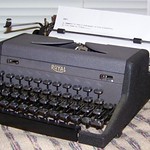A device that could help students with reading difficulties.
Read MoreReading and technology
 What do you think of when you see the words “reading” and “technology” in the same sentence? I tend to think of e-book readers and how easy it is to transfer stuff to, and then read, on my phone. But there is more to it than that. According to Dyslexia Action, around one in ten students struggle to read standard print.
What do you think of when you see the words “reading” and “technology” in the same sentence? I tend to think of e-book readers and how easy it is to transfer stuff to, and then read, on my phone. But there is more to it than that. According to Dyslexia Action, around one in ten students struggle to read standard print.
Typewriters? No thanks!
 There is something romantic about an old manual typewriter. The clattering of the keys sounds somewhat industrial, which connotes “industrious”. Bashing away at a typewriter is what real writers do. No spellchecker, no thesaurus, no internet, and no forgiveness if you make a mistake. So typing something that looked reasonable, and which didn’t involve too much correction fluid, gave one a sense of achievement.
There is something romantic about an old manual typewriter. The clattering of the keys sounds somewhat industrial, which connotes “industrious”. Bashing away at a typewriter is what real writers do. No spellchecker, no thesaurus, no internet, and no forgiveness if you make a mistake. So typing something that looked reasonable, and which didn’t involve too much correction fluid, gave one a sense of achievement.
Hidden treasures
 We’ve probably all heard the statistic that 80% of people use only 20% of a program’s features – but that doesn’t mean to say that the unused features are no good. It could be that people haven’t discovered them, or could not find an obvious use for them, or that they have simply forgotten about them.
We’ve probably all heard the statistic that 80% of people use only 20% of a program’s features – but that doesn’t mean to say that the unused features are no good. It could be that people haven’t discovered them, or could not find an obvious use for them, or that they have simply forgotten about them.
Putting dyslexia first with technology
 One of the things that it is all too easy to forget is that if a child is ‘playing up’ in class, it could be a disability issue rather than a behavioural one. I have known that for a long time, but attending a Technology for Print Disabilities Training Day served as a useful reminder. That training day, just to put this article in context, was run by Load2Learn, a partnership venture between Dyslexia Action and the RNIB.
One of the things that it is all too easy to forget is that if a child is ‘playing up’ in class, it could be a disability issue rather than a behavioural one. I have known that for a long time, but attending a Technology for Print Disabilities Training Day served as a useful reminder. That training day, just to put this article in context, was run by Load2Learn, a partnership venture between Dyslexia Action and the RNIB.
Review of the Technology for Print Disabilities Training Day
 When I was invited to attend the Technology for Print Disabilities training day, run by Dyslexia Action, I was filled with a sense of dread. True, it was free. But I’d have to leave the house at the crack of dawn, travel a couple of hundred miles, return well into the evening – and all for a topic which I assumed had only a tangential relevance to my day-to-day work. Nevertheless, applying the deep philosophical outlook I learnt listening to Fats Waller (“One never knows, do one?”), I said to myself, “OK, let’s give it a whirl.”
When I was invited to attend the Technology for Print Disabilities training day, run by Dyslexia Action, I was filled with a sense of dread. True, it was free. But I’d have to leave the house at the crack of dawn, travel a couple of hundred miles, return well into the evening – and all for a topic which I assumed had only a tangential relevance to my day-to-day work. Nevertheless, applying the deep philosophical outlook I learnt listening to Fats Waller (“One never knows, do one?”), I said to myself, “OK, let’s give it a whirl.”